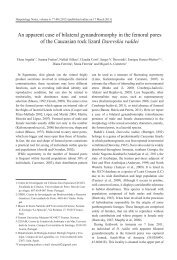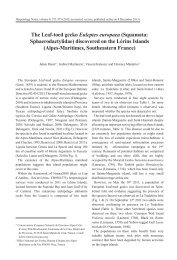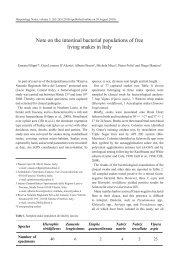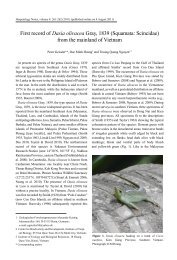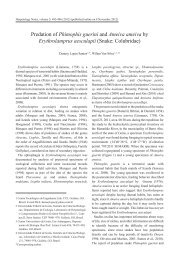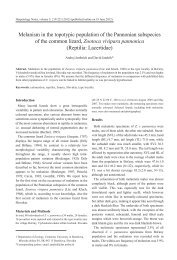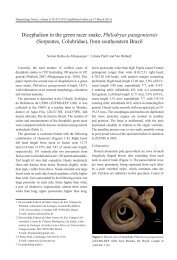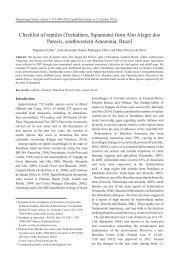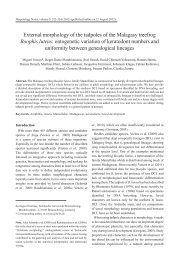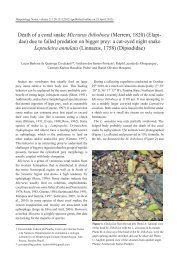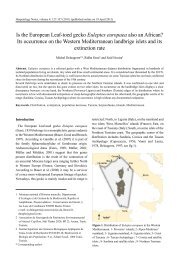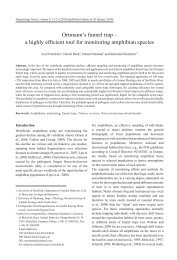Multiple and heterospecific amplexi between the toads Rhaebo ...
Multiple and heterospecific amplexi between the toads Rhaebo ...
Multiple and heterospecific amplexi between the toads Rhaebo ...
Create successful ePaper yourself
Turn your PDF publications into a flip-book with our unique Google optimized e-Paper software.
Herpetology Notes, volume 4: 167-169 (2011) (published online on 6 May 2011)<br />
<strong>Multiple</strong> <strong>and</strong> <strong>heterospecific</strong> <strong>amplexi</strong> <strong>between</strong> <strong>the</strong> <strong>toads</strong><br />
<strong>Rhaebo</strong> guttatus <strong>and</strong> Rhinella marina (Anura: Bufonidae)<br />
Reginaldo Assêncio Machado* <strong>and</strong> Paulo Sérgio Bernarde<br />
Male anurans exhibit four alternative behavioral<br />
strategies to form an <strong>amplexi</strong> (Pombal-Júnior <strong>and</strong><br />
Haddad, 2007): (1) active search for females, (2)<br />
displacing o<strong>the</strong>r males in <strong>amplexi</strong>, (3) satellite male<br />
behavior <strong>and</strong> (4) poly<strong>and</strong>ry. The active search for<br />
females <strong>and</strong> <strong>the</strong> behavior of displacing o<strong>the</strong>r males<br />
in already-formed <strong>amplexi</strong> occur mainly when <strong>the</strong><br />
number of females is smaller than <strong>the</strong> number of<br />
males during reproduction (Davies <strong>and</strong> Halliday,<br />
1977; Wogel, Abrunhosa <strong>and</strong> Pombal-Júnior, 2005;<br />
Pombal-Júnior <strong>and</strong> Haddad, 2007). According to Wells<br />
(1977), differences in anuran advertisement calls is<br />
one mechanism to reduce <strong>heterospecific</strong> matings (see<br />
Haddad, Pombal-Júnior <strong>and</strong> Batistic, 1994; Haddad,<br />
Cardoso <strong>and</strong> Castanho, 1990). Cases of hybridization<br />
were recorded in many bufonids both in tropical genera<br />
such as Anaxyrus <strong>and</strong> Rhinella (Feder, 1979; Sullivan,<br />
1986; Haddad, Cardoso <strong>and</strong> Castanho, 1990) but also in<br />
temperate species (e.g. McCoy, Smith <strong>and</strong> Tihen 1967,<br />
Hemmer 1973). In those genera, in which explosive<br />
reproduction is frequent, errors in <strong>the</strong> formation of<br />
couples may occur due to <strong>the</strong> strategies ‘active search’<br />
<strong>and</strong> ‘displacement of males’, <strong>and</strong> also because of <strong>the</strong> low<br />
selectivity of females (Haddad, Cardoso <strong>and</strong> Castanho,<br />
1990).<br />
Here we present records of <strong>heterospecific</strong> couples<br />
<strong>and</strong> of multiple <strong>amplexi</strong> <strong>between</strong> <strong>Rhaebo</strong> guttatus <strong>and</strong><br />
Rhinella marina, two common toad species found<br />
in sympatry in many localities across <strong>the</strong> Amazon<br />
(Duellman, 1990; Caldwell <strong>and</strong> Araújo, 2005; Bernarde,<br />
2007).<br />
The records were made in Parque Nacional do Juruena<br />
(PNJ), nor<strong>the</strong>rn Mato Grosso state <strong>and</strong> sou<strong>the</strong>astern<br />
Laboratório de Herpetologia, Universidade Federal do Acre,<br />
Campus Universitário Floresta, Km 12, Gleba Formoso,<br />
69.980-000, Cruzeiro do Sul, Acre;<br />
e-mail: anurans@uol.com.br<br />
*Corresponding author.<br />
Amazonas state, which extends nearly up to two<br />
million hectares. PNJ is located within <strong>the</strong> Brazilian<br />
Central Amazon, characterized by a high diversity<br />
of vegetation mosaics <strong>and</strong> soils, <strong>and</strong> where <strong>the</strong>re are<br />
transitional areas <strong>between</strong> semi-deciduous seasonal<br />
forest <strong>and</strong> dense rainforest, as well as <strong>between</strong> those<br />
vegetations <strong>and</strong> Cerrado (RADAMBRASIL, 1980). On<br />
<strong>the</strong> nights of March 6 th , 7 th <strong>and</strong> 9 th 2008, we observed<br />
individuals of <strong>Rhaebo</strong> guttatus <strong>and</strong> Rhinella marina in<br />
reproductive activity. We recorded <strong>and</strong> photographed<br />
<strong>the</strong>ir behavior. Males of those species were vocalizing<br />
<strong>and</strong> also actively searching for females on <strong>the</strong> margins<br />
of <strong>the</strong> rivers Teles Pires (7°31’S, 57°58’W) <strong>and</strong> Tapajós<br />
(7°5’S, 58°14’W).<br />
On <strong>the</strong> night of March 6 th , around 19:30, we found a<br />
male of Rhinella marina in <strong>amplexi</strong> with a female of<br />
<strong>Rhaebo</strong> guttatus, while ano<strong>the</strong>r male of <strong>Rhaebo</strong> guttatus<br />
was trying to displace <strong>the</strong> first male, even while it was<br />
itself in <strong>amplexi</strong> with ano<strong>the</strong>r conspecific male (Figure<br />
1a). On <strong>the</strong> following night, March 7 th , around 21:40,<br />
we recorded three male of Rhinella marina <strong>and</strong> one<br />
male of <strong>Rhaebo</strong> guttatus in <strong>amplexi</strong> with a female of<br />
Rhinella marina (Figure 1b). On <strong>the</strong> same night, at<br />
21:44, we also observed a male of <strong>Rhaebo</strong> guttatus in<br />
<strong>amplexi</strong> with a female of Rhinella marina (Figure 1c).<br />
On March 9 th , around 18:30, a male of Rhinella marina<br />
was recorded in <strong>amplexi</strong> with a male of <strong>Rhaebo</strong> guttatus<br />
(Figure 1d).<br />
During <strong>the</strong> explosive reproduction of <strong>Rhaebo</strong> guttatus<br />
<strong>and</strong> Rhinella marina, <strong>the</strong> reproductive strategy ‘active<br />
search’ is more frequent, <strong>and</strong> increases <strong>the</strong> chance of<br />
<strong>heterospecific</strong> couples <strong>and</strong> multiple <strong>amplexi</strong> (Pombal-<br />
Júnior <strong>and</strong> Haddad, 2007). At that time Rhinella male<br />
<strong>toads</strong> are little selective, getting closer <strong>and</strong> forming<br />
<strong>amplexi</strong> with anything that moves nearby (see<br />
Haddad, Cardoso <strong>and</strong> Castanho, 1990; Haddad <strong>and</strong><br />
Sazima, 1992). <strong>Rhaebo</strong> guttatus <strong>and</strong> Rhinella marina<br />
are easily identified via <strong>the</strong>ir mating calls (PSB <strong>and</strong><br />
RAM, personal observation), as it was registered in<br />
<strong>the</strong> Atlantic Forest for Rhinella ornata <strong>and</strong> R. icterica
168<br />
Reginaldo Assêncio Machado & Paulo Sérgio Bernarde<br />
Figure 1. Heterospecific couples <strong>and</strong> multiple <strong>amplexi</strong> <strong>between</strong> <strong>Rhaebo</strong> guttatus <strong>and</strong> Rhinella marina: (A) a male of R. marina<br />
<strong>and</strong> two males of R. guttatus in <strong>amplexi</strong> with a female of R. guttatus (photo by RAM); (B) three males of R. marina <strong>and</strong> a male of<br />
R. guttatus in <strong>amplexi</strong> with a female of R. marina (photo by PSB); (C) a male of R. guttatus in <strong>amplexi</strong> with a female of R. marina<br />
(photo by PSB); (D) a male of R. marina in <strong>amplexi</strong> with a male of R. guttatus (photo by RAM).<br />
(Haddad, Cardoso <strong>and</strong> Castanho, 1990; Haddad <strong>and</strong><br />
Sazima, 1992). However, as for <strong>the</strong> two species of<br />
Rhinella from <strong>the</strong> Atlantic Forest (see Haddad, Cardoso<br />
<strong>and</strong> Castanho 1990), this difference was not enough to<br />
prevent <strong>amplexi</strong> <strong>between</strong> <strong>heterospecific</strong> <strong>toads</strong> R. marina<br />
<strong>and</strong> R. guttatus. Despite <strong>the</strong> many ways that multiple<br />
<strong>amplexi</strong> influence sexual selection of organisms with<br />
external fertilisation such as anurans (Vieites et al.,<br />
2004), <strong>heterospecific</strong> matings may result in unviable<br />
hybrids. Energetically this is would a waste in terms<br />
of gametes <strong>and</strong> results in reproductive failure of <strong>the</strong><br />
individuals involved (Haddad, Cardoso <strong>and</strong> Castanho,<br />
1990). Sympatry, syntopy <strong>and</strong> explosive reproduction<br />
also favor <strong>heterospecific</strong> matings (Haddad, Cardoso <strong>and</strong><br />
Castanho, 1990). Bernarde (2007), in Espigão do Oeste,<br />
state of Rondônia, Brazil, recorded <strong>the</strong>se two species in<br />
synchronopatry, though <strong>heterospecific</strong> couples were not<br />
observed (PSB, personal observation).<br />
When many males try to form an <strong>amplexi</strong> with a<br />
female, <strong>the</strong>re are many strategies to exclude competing<br />
males (Lamb, 1984), but <strong>the</strong> displacer male takes <strong>the</strong> risk<br />
of killing <strong>the</strong> female (Trauth, Mccallum <strong>and</strong> Cartwright,<br />
2000; RAM, personal observation). Amplexi formed<br />
with large males may constrain locomotion <strong>and</strong> feeding<br />
of females, <strong>and</strong> this constraint increase when multiple<br />
males are involved in <strong>the</strong> <strong>amplexi</strong> (Bowcock, Brown<br />
<strong>and</strong> Shine, 2009).<br />
Aknowledgments. Instituto Brasileiro do Meio Ambiente e dos<br />
Recursos Naturais Renováveis (IBAMA) granted <strong>the</strong> license<br />
for scientific activities (License: 12171-1, Record in IBAMA:<br />
1909428). Instituto Centro de Vida (ICV) <strong>and</strong> Instituto Chico<br />
Mendes de Conservação da Biodiversidade (ICMBio) provided<br />
us with logistic support, both in <strong>the</strong> municipality of Alta Floresta,<br />
state of Mato Grosso, Brazil. CNPq provided fellowships to R. A.<br />
Machado (502736/2009-7), <strong>and</strong> P. S. Bernarde (501927/2009-3)<br />
References<br />
Bernarde, P.S. (2007): Ambientes e temporada de vocalização<br />
da anurofauna no Município de Espigão do Oeste, Rondônia,<br />
Sudoeste da Amazônia - Brasil (Amphibia: Anura). Biota Neotropica<br />
7: 87-92.
<strong>Multiple</strong> <strong>and</strong> <strong>heterospecific</strong> <strong>amplexi</strong> <strong>between</strong> <strong>Rhaebo</strong> guttatus <strong>and</strong> Rhinella marina 169<br />
Bowcock, H., Brown, G.P., Shine, R. (2009): Beastly Bondage:<br />
The Costs of Amplexi in Cane Toads (Bufo marinus). Copeia<br />
2009: 29-36.<br />
Caldwell, J.P., Araújo, M.C. (2005): Amphibians faunas of two<br />
eastern amazonian rainforest sites in Pará, Brazil. Occasional<br />
Papers Sam Noble Oklahoma Museum of Natural History 16:<br />
1-41.<br />
Davies, N.B., Halliday, T.R. (1977): Optimal mate selection in <strong>the</strong><br />
toad, Bufo bufo. Nature 269: 56-58.<br />
Duellman, W.E. (1990): Herpetofaunas in Neotropical rainforests:<br />
comparative composition, history, <strong>and</strong> resource use. In:<br />
Four Neotropical Rainforests, p. 455-505. Gentry, A.H., Ed.,<br />
New Haven, Yale University Press.<br />
Feder, J.H. (1979): Natural hybridization <strong>and</strong> genetic divergence<br />
<strong>between</strong> <strong>the</strong> <strong>toads</strong> Bufo boreas <strong>and</strong> Bufo punctatus. Evolution<br />
33: 1089-1097.<br />
Haddad, C.F.B., Cardoso, A.J., Castanho, L.M. (1990): Hibridação<br />
natural entre Bufo ictericus e Bufo crucifer (Amphibia,<br />
Anura). Revista Brasileira de Biologia 50: 739-744.<br />
Haddad, C.F.B., Pombal-Júnior., J.P., Batistic, R.F. (1994): Natural<br />
hybridization <strong>between</strong> diploid <strong>and</strong> tetraploid species of<br />
leaf-frogs, genus Phyllomedusa (Amphibia). Journal of Herpetology<br />
28: 425-430.<br />
Haddad, C.F.B., Sazima, I. (1992): Anfíbios anuros da Serra do<br />
Japi. In: História Natural da Serra do Japi: Ecologia e preservação<br />
de uma área florestal no Sudeste do Brasil, p. 188-211. Morellato,<br />
L.P.C., Ed., Campinas, Editora da Unicamp/FAPESP.<br />
Hemmer, H. (1973): Die Bastardierung von Kreutzkröte (Bufo<br />
calamita) und Wechselkröte (Bufo viridis). Salam<strong>and</strong>ra 9: 118-<br />
136.<br />
Lamb, T. (1984): Amplexi displacement in <strong>the</strong> sou<strong>the</strong>rn toad,<br />
Bufo terrestris. Copeia 1984: 1023-1025.<br />
McCoy, C.J., Smith, H.M., Tihen, J.A. (1967): Natural Hybrid<br />
Toads, Bufo punctatus <strong>and</strong> Bufo woodhousei, from Colorado.<br />
The Southwestern Naturalist 12: 45-54.<br />
Pombal-Júnior, J.P., Haddad, C.F.B. (2007): Estratégias e modos<br />
reprodutivos em anuros. In: Herpetologia no Brasil II, p.101-<br />
116. Nascimento, L.B., Oliveira, M.E., Eds., Belo Horizonte,<br />
Sociedade Brasileira de Herpetologia.<br />
RADAMBRASIL (1980): Folha Juruena, SC.21: Geologia, geomorfologia,<br />
solos, vegetação e uso potencial da terra. Rio de<br />
Janeiro. DNPM/MME Projeto RADAMBRASIL.<br />
Sullivan, B.K. (1986): Hybridization <strong>between</strong> <strong>the</strong> <strong>toads</strong> Bufo microscaphus<br />
<strong>and</strong> Bufo woodhousii in Arizona: morphological<br />
variation. Journal of Herpetology 20: 11-21.<br />
Trauth, S.E., Mccallum, M.L., Cartwright, M.E. (2000): Breeding<br />
mortality in <strong>the</strong> wood frog, Rana sylvatica (Anura: Ranidae),<br />
from Northcentral Arkansas. Journal of <strong>the</strong> Arkansas Academy<br />
of Science 54: 154-156.<br />
Vieites, D.R., Nieto-Román, S., Barluenga, M., Palanca, A.,<br />
Vences, M., Meyer, A. (2004): Post-mating clutch piracy in an<br />
amphibian. Nature 431: 305-308.<br />
Wells, K.D. (1977): The courtship of frogs. In: The reproductive<br />
biology of amphibians, p. 233-262. Taylor, D.H., Guttman,<br />
S.I., Eds., New York, Plenum Press.<br />
Wogel, H., Abrunhosa, P.A., Pombal-Júnior, J.P. (2005): Breeding<br />
behaviour <strong>and</strong> mating success of Phyllomedusa rohdei (Anura,<br />
Hylidae) in south-eastern Brazil. Journal of Natural History<br />
39: 2035-2045.<br />
Accepted by Sebastian Steinfartz



